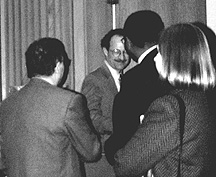
| T H E N I H C A T A L Y S T | M A Y – J U N E 1999 |
|
|
|
NIH SEES SILVER LINING IN COPR |
 |
|
COPR
participants bid NIH director Harold Varmus adieu at meeting's end.
|
From the outset, NIH Director Harold Varmus gently hinted that creating a new advisory group of public representatives was not exactly his idea. But in opening comments at the first meeting of the Committee of Public Representatives (COPR, or "Copper") on April 21, Varmus indicated he now embraces the new committee and plans to test its mettle.
The idea for COPR had its origins in an Institute of Medicine (IOM) report that capped a congressionally mandated study of how NIH sets its research priorities and interacts with the public. Two or three years ago, Varmus said, Congress was contemplating major increases in NIH’s budget but wanted to be sure that this largess was well-spent from all points of view. Doubting that word about the treasures of NIH research was indeed reaching the ears of their constituents, Congress directed the IOM to conduct the study.
For its part, the IOM produced a report in which lay the seeds of COPR, Varmus said. Despite the presence of public members on advisory panels to the NIH director and to the institutes and centers—and despite the steady presence of disease interest groups at the NIH campus—the IOM deemed NIH’s interaction with the public insufficient.
An ad hoc group appointed from a list of people familiar with NIH met with Varmus in September. The group recommended that the citizens’ committee that would be named COPR include a broad mix of members—patients, scientists, administrators, advocates—and that the NIH director have the last word on selection.
To counteract what seemed at first like a prescription for factionalism, Varmus set stringent selection criteria, including the ability to think globally, exercise leadership, analyze problems, communicate well, and work effectively in a group. An ad was posted in the Federal Register and e-mails went out to all of the institutes’ contacts in every constituency group. Other federal agencies helped spread the word, and special attention was paid to recruiting members representative of minority groups. "The word got out there," says NIH communications director, Anne Thomas, charged with coordinating COPR’s activities. The ads and letters drew 250 applications, many of them glittering.
In fact, Varmus was so impressed with the quality of the applications that picking the final group of 20 was very difficult. Unwilling to cut the remaining applicants loose, Varmus invited all 230 to become "COPR Associates." He told the COPR members that he envisions the "Associates" as a place to which COPR members might "retire" and from which new members might be drawn. He said he expects to let the Associates group largely run itself, serving as a conduit to and from the general public, much like the official group. Thomas says she has already had requests from institutes for help and advice from COPR associates.
The credentials of the COPR proper shine like a new penny. The members went around the table, introducing themselves to one another (see below) and the assorted onlookers that made up the audience to this open meeting. Some had prior experience serving on NIH advisory groups; some had been involved in NIH-funded research—either as principal investigators or clinical trial participants; some were afflicted with the disease that dominated their advocacy work; none was a stranger to the complexity of competing and overlapping interests in health research policy and funding; and some made a point of affirming their willingness to cast a wider net of concern than their particular bailiwick during their COPR service.
Varmus told the group that serving on the committee would be no free ride. In addition to meetings twice a year, he expects COPR to have a constant dialogue with NIH, either through him or through Thomas. He expects COPR members to serve on advisory and review panels, conduct studies and analyses, lead the COPR associates, and evaluate how well NIH manages its relations with the public and constituency groups.
Just as he has put his Advisory Committee to the Director to work on technical and scientific issues, Varmus said, COPR members can expect to roll up their shirtsleeves on issues that pertain to the public, to patient populations, and public health. Examples include ethical issues, privacy of medical information, and embryo research, Varmus said.
Underscoring his intention
to mine the COPR, Varmus asked the group to stipulate those activities they
would want to involve themselves in "in a more intense way" and noted
that the next COPR meeting would likely include a report back to the group of
discussions arising during a "budget retreat" slated for June, as
well as address the protection of research subjects, complementary and alternative
medicine, and how to expand access to the "remarkable resources of the
Internet and make the whole nation interactive." Additional items suggested
by COPR members included technology transfer, the Human Genome Project, and
the logistics and ethics of research conducted abroad—especially vaccine
research. ![]()